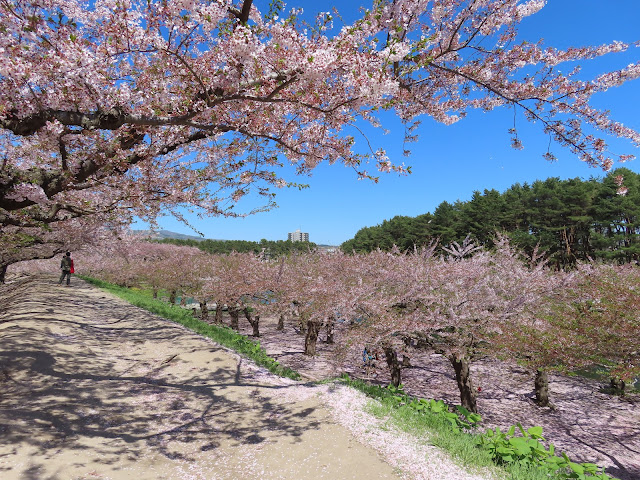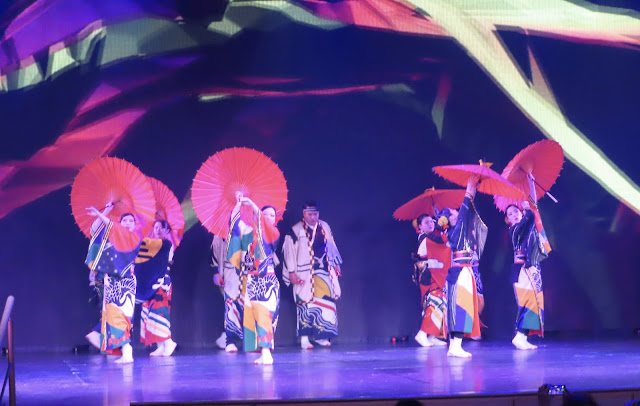Thursday, May 2, 2024
"Also-ran" means, a contestant in a race who fails to win or to place among the first three finishers, or an athlete or team whose performance in competition is rarely, if ever, a winning or near-winning one. (Thanks, dictionary.com) That sounds a lot like Muroran.
Muroran (pop. 76,00) is a port on the south coast of Hokkaido. According to TripAdvisor, the number one thing to "do" in Muroran is the Hakucho Bridge. It's a big bridge. Okay, and . . .?
On a previous visit to Muroran we took an excursion to the Valley of Hell + a Ninja Show. The Valley of Hell was an active geothermal site, similar to places we have seen in Iceland and New Zealand. I have not seen any other Ninja shows to compare the one we saw in Muroran with, but it seemed a little amateurish. So we didn't want to go on that tour again, and there weren't any other tours that urgently required our presence, so we decided we would just walk around the center of town.
 |
| Yet another group of cute pre-schoolers appeared on the dock to wave at our ship |
All day long people from Muroran showed up at the dock to see our ship. We had a great view of all the action from our balcony - people from our ship as well as people from town, with a few food trucks thrown in.
We were docked some distance away so we had to take a shuttle into town.
Our lack of research was not such a smart move. We got off at a JR station, but it was not the main Muroran station. I think it was one for the east side of Muroran. How would we have known? That's where the shuttle stopped, though it did have another stop.
At the station there was a large map showing different walking routes to points of interest. We picked one and started walking, hoping there would be some level of wayfinding to guide us along. There wasn't.
After two or three blocks we came to a major intersection. There was no indication as to which way we should go. Not only that, it was impossible to cross the street in any direction without climbing up and over a monstrous structure that dominated the intersection. At ground level, the curbs were all completely fenced off. You were forced to go up.
The photos really don't do this thing justice. It was huge. It covered a huge amount of real estate with all of its ramps and staircases and supports. It went completely around the intersection. Once you got up there, you could see that all four corners were connected by these raised walkways.
We climbed up grudgingly, and kept going in the direction we had been going in, toward a large store on the far corner. The one thing that the store had to recommend it was access directly from the elevated walkway. Well, boy howdy, we should go in right up here, we said.
The store was roughly similar to a Walmart, but without the greeters. They sold a little bit of this and a little of that. There were groceries and a large drug store on the street level, and furniture on level 2, where we entered. Level 3 had crafts and clothes, housewares and knick-knacks.
Ken bought 3 mini-windsocks on a stick and I bought some washi tape. We also bought a lot of snacks (for the crossing) at the grocery store. (Did I mention that our final port, Kushiro, had been canceled, so this was to be our last stop before Whittier?)I bought some shampoo and conditioner at the drug store because I didn't like the kind supplied by Princess. The drug store offered an overwhelming variety of hair products (with the exception of products for curly hair). It was interesting to see that most of the toiletries were sold in more sustainable packaging. Considering that Muroran has got to be at the tail end of the supply chain, this makes a lot of sense. I didn't really notice what they were selling in Tokyo, though.
This is roughly 12 ounces of hair conditioner
By the way, it says "Filled with firmness - even wavy hair is tidied up." I love shopping in Japan.
After looking at everything in the store, we realized that by the time we got back to the JR Station, there could be a long line for the shuttle bus, and it might already be full with folks who boarded at the other stop. We had lost interest in continuing our walking tour, especially if there could be more of those gruesome intersections, so we headed back to the JR Station to wait for our shuttle. The transit company had posted a couple of people at the bus stop to make sure everybody got on the right shuttle and we all made it back to the ship without incident.
Today’s fabric is Beige Traditional Japanese Fabric, 100% cotton, sold on Etsy by AsianFabrics.






























